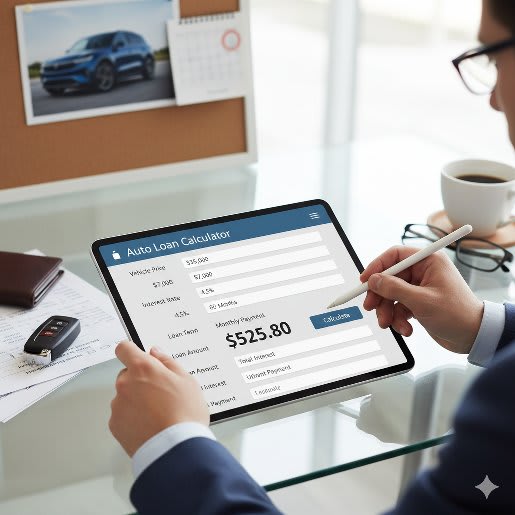
To get the most accurate estimate, you'll need a few key pieces of information.
- Price of Vehicle - Enter the car's sticker price (MSRP) or, even better, the negotiated price you plan to pay. This is the starting point for all the calculations.
- Down Payment - This is the amount of cash you will pay upfront. A larger down payment reduces your loan amount, which in turn lowers your monthly payment and the total interest you'll pay. Generally, experts recommend a down payment of 20% for a new car and 10% for a used car.
- Trade-In Value & Amount Owed-If you are trading in your current vehicle, enter its value in the Trade-In Value field. You can get an estimate from online valuation tools or a direct offer from a dealer.In the Amount Owed on Trade-In field, enter the remaining balance on your current auto loan (your "payoff amount").
- If your trade-in is worth more than you owe, the calculator will apply the positive equity, reducing your total loan amount.
- If you owe more than it's worth (known as negative equity), the calculator will add that remaining balance to your new loan.
- Annual Interest Rate (APR) - This is the total yearly cost of borrowing, expressed as a percentage. It typically includes both the interest rate and certain lender fees. Actual APRs vary by lender and are subject to creditworthiness and loan terms.
- Loan Term (Months)- Enter the number of months you plan to take to repay the loan. Common terms are 36, 48, 60, 72, or even 84 months.
- Shorter terms (like 48 months) have higher monthly payments but save you a significant amount of interest.
- Longer terms (such as 72 months) have lower, more attractive monthly payments, but you will pay significantly more in total interest.
- Sales Tax Rate - Enter your state and local sales tax rate as a percentage. The calculator will determine the taxable amount (typically the vehicle price minus your trade-in's value) and calculate the sales tax you are required to pay.
After you enter your information, the calculator will generate a breakdown of your estimated loan.
Monthly Payment - This is the primary result and the amount you can expect to pay your lender each month for the life of the loan.
Loan Amount - This is the total principal amount you are borrowing. Our calculator determines this by taking the Vehicle Price and subtracting your Down Payment and any Trade-In Equity, while adding any Negative Equity from your trade-in.
Upfront Payment - This is your total estimated cash due at signing. This calculator determines this figure by adding your Down Payment to the Calculated Sales Tax. This assumes you are paying for taxes in cash upfront rather than rolling them into the loan.
Total Interest Cost - This is the total amount of interest you will pay over the entire loan term. Seeing this number can be a powerful motivator to choose a shorter loan term or make a larger down payment to reduce the overall cost of borrowing.
Total Loan Payments - This is the sum of your Loan Amount plus the Total Interest Cost. It represents the full amount you will have paid to your lender by the end of the loan term.
The calculator is also a practical planning tool that allows you to adjust the numbers and explore different ways to save money. There are a few strategies you can try to make the most of your savings:
Test Different Loan Terms - Toggle the loan term between 48, 60, and 72 months. You’ll notice that extending the loan term lowers your monthly payment, but it also increases the total interest cost. This helps you find the right balance between an affordable payment and a total cost you’re comfortable with.
See the Impact of a Larger Down Payment - Try increasing the Down Payment by $1,000 or $2,000 to see how it lowers both your Monthly Payment and Total Interest Cost. This will help you understand the real benefit of saving a bit more before making your purchase.
Know Your Credit Score - Your credit score has the single biggest impact on your Interest Rate (APR). A higher credit score can get you a lower APR, potentially saving you thousands of dollars in interest. Before you shop, check your credit and take steps to improve it if necessary.
- Principal vs. Interest: The principal is the amount of money you borrowed. Interest is the fee you pay to the lender for borrowing that money. Each monthly payment you make is split between paying down the principal and paying the interest.
- APR (Annual Percentage Rate): This is a more complete measure of a loan's cost than the simple interest rate. It includes the interest rate plus any lender fees (like origination fees), giving you a true "apples-to-apples" comparison of loan offers.
- Trade-In Equity vs. Negative Equity: If your trade-in car is worth $15,000 and you owe $10,000, you have $5,000 in positive equity that acts like an extra down payment. If your car is worth $15,000 but you owe $18,000, you have $3,000 in negative equity (also called being "upside down"), which is added to your new loan principal.
Once you have an estimate you're comfortable with, here's what to do next.
1. Get Pre-approved for a Loan
Before you go to the dealership, get pre-approved for an auto loan from your bank, a local credit union, or an online lender. This will provide a realistic interest rate and establish a firm budget.
2. Compare Offers from Multiple Lenders
Don't just take the first offer you get. Apply to at least three different lenders to see who can give you the most competitive APR. A single percentage point can make a big difference in your total interest cost.
3. Focus on the Total Cost, Not Just the Payment
The dealership may try to focus you on the monthly payment. Use your calculator results to stay focused on the Total Loan Payments and Total Interest Cost. A low monthly payment isn't a good deal if it's attached to a very long loan term that costs you thousands more in the end.
Disclaimer: The figures generated by this calculator are estimates only and should not be considered binding loan offers. Final terms may vary based on your credit profile, lender policies, and applicable state regulations.
All lending offers are subject to approval by licensed financial institutions. Consumers are encouraged to review terms carefully and consult with a financial advisor if needed.


